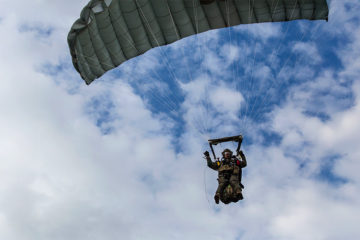Experts at Aviation Week conference reveal three ways to improve the defense startup ecosystem

Earlier this month, Aviation Week Network hosted the annual A&D Programs Conference in Washington, D.C.. Attended by C-suite industry executives and government leaders, this event provides business intelligence and networking opportunities for industry and defense attendees, and this year’s event focused on the theme of “Building a Resilient Industrial Base.” Three core focus areas included business strategy, supply chain opportunities, and program excellence.
Participants at the Aviation Week panel discussion, “Keeping Our Edge: Innovation and National Security,” spoke about how The U.S. Department of Defense and industry engage with one another, software-driven technologies, and innovative programs.
The panel included:
- Steve Trimble, Defense Editor, Aviation Week, Moderator
- Andrea Garrity, Chief Growth Officer, goTenna
- Michael Weigand, Chief Growth Officer, Shift5
Both panelists brought unique perspectives on how startups can adapt and bring agile solutions to meet the complex challenges presented by the U.S. government, focusing on moving at the speed of the mission, public-private partnership, and defining success metrics in advance.
-
Moving at the speed of the mission
Each panelist described how their company is working directly with the government to address the real-time needs of their end users.
Andrea opened up the conversation by discussing how goTenna addresses the fast-paced and changing needs of the U.S. government by offering a product that can be easily deployed with no cellular infrastructure or SATCOM availability, giving operators a flexible way to deploy off-grid in a last-mile environment. Specifically, she explained how goTenna’s ability to move short-burst data in a narrow band became a potential fit in the Navy’s Project Overmatch Program.
“If you’re on a ship and getting jammed, and big pipes become small pipes, how do you continue receiving data?” said Andrea.
As part of the program, goTenna was able to take its mesh networking protocol, Aspen Grove, out of the radio itself and install it directly into an IP layer, giving the U.S. Navy the ability to continue to move critical data through a network outside of traditional voice radio or satellite systems.
“The key to us is really understanding who are the partners that we can bring value to. We almost always approach the program manager and the OEM simultaneously.” – Michael Weigand
Michael added how his company, Shift5, initially provided security for weapons systems. Since then, they have pivoted out of a need for intrusion detection and prevention. As it became an area of concern for the Government Accountability Office (GAO), the company built a product that allows observability and data democratization for operational lethality and survivability. He also mentioned that Shift5 recently signed their first contracts for air and ground systems for the Air Force, and the Army focused on those use cases.
Michael said that startups need to “show up and go where the work is,” which involves studying strategy documents and coming prepared with the right questions to ensure that startups are in sync with government needs.
“The software side needs to continually educate some of our newer customers that we’re on board and that software is not static. If you expect it to be secure and operational in five or ten years, then you need to continue to invest in updating that,” said Michael.
Andrea recommended that setting benchmarks for success upfront for both the government and startup is crucial to stay in line with evolving government needs. “We talked about this a lot at In-Q-Tel. How do you define success? If you have a technology that sits on the shelf for a year, but it gets used once in a very critical mission, and it’s successful, how, as a company, will you talk to other agencies and say we did this one thing?”
She also talked about how companies often struggle to provide the government with urgent solutions because it can take 18 to 24 months for the government to award a follow-on contract to bring the solution to life on an enterprise scale. By sharing priorities with startups, companies can continue to focus on near-peer conflict solutions or shift their focus elsewhere.
-
Building trust and credibility through partnerships
Andrea and Michael discussed how startups should engage with government offices when developing and testing new industry capabilities.
“There seems to be a drop-off when we say, ‘We’ve worked with the end user, we’ve done the development, where do we go from here?’” – Andrea Garrity
“A key part of our success has been partnership,” said Michael. “The key to us is really understanding who are the partners that we can bring value to. We almost always approach the program manager and the OEM simultaneously.”
Andrea added: “I think for [goTenna], we’ve been fortunate to have a lot of government experience, so we can talk to the PMs and have those introductions. In my last job, I saw companies eager to support the mission but don’t know who anybody is [on the government side].”
She shared how In-Q-Tel conducts strategic tech scouting by meeting with over 800 startups annually. Then, In-Q-Tel shares that information with the government, specifically which tech they believe is a good fit and which has dual use. This includes understanding the different technology founders and gaps that the government agencies have. In-Q-Tel also helped the government see which companies can help solve a mission or fill a void, even with minor adjustments.
“With DIU and AFWERX, it’s then how do you take that company that has successfully developed a product and get them into an ecosystem where they have relationships, where they understand the language, where they know who the right people are to get in front of to have the chance to demonstrate their pitch or their tech,” added Andrea.
-
Continuous education and engagement after contract awards
Andrea also spoke about the struggle for momentum after a startup receives its first government contracting award. She cited a concern that once a startup has the capability ready, they often struggle to get it out or beyond the front door because it’s unclear how engagement should look going forward.
“There seems to be a drop-off when we say, ‘We’ve worked with the end user, we’ve done the development, where do we go from here?’” said Andrea. “The challenge is when you have an AFWERX program, your phase two [contract], and you deliver successfully, it’s important to figure out how you jump to a program of record. Maybe it’s not your program of record, and maybe it’s nesting under another program of record.”
“If you’re on a ship and getting jammed, and big pipes become small pipes, how do you continue receiving data?” – Andrea Garrity
Michael emphasized the importance of entrusting programs and PEOs to have a more significant percentage of their discretionary budget. He believes this creates the white space that enables those program managers and their staff to identify the technologies and help get across the “valley of death” until they can get to some type of requirement with substantial funding.
Andrea mentioned that goTenna takes more of a hybrid approach. She spoke about how goTenna has a tactical, decentralized solution relevant to current conflicts. This is how goTenna strategically engages and moves towards the program of record.
“goTenna continually develops conversations and can also field new capabilities to the operators. From my perspective, we’ve just been lucky we’ve been able to do both,” said Andrea.
The panel concluded with a focus on how to make growth more manageable and improve government procurement timelines. This includes securing funding before contract awards and expediting government onboarding requirements such as NDA processes. It’s also essential to ensure that funding is secured before the award and available for scaling a specific solution or project in the future.
The renewed emphasis on near-peer, pacing threats underscores the heightened urgency to swiftly lower the barriers to innovation and expedite the government acquisition process for proven capabilities. To facilitate this, the U.S. government must continue reshaping its acquisition culture, fostering an environment that treats solution providers as esteemed and trusted partners.
Click here to learn how goTenna connects air-to-ground operators and moving assets.









No Comment